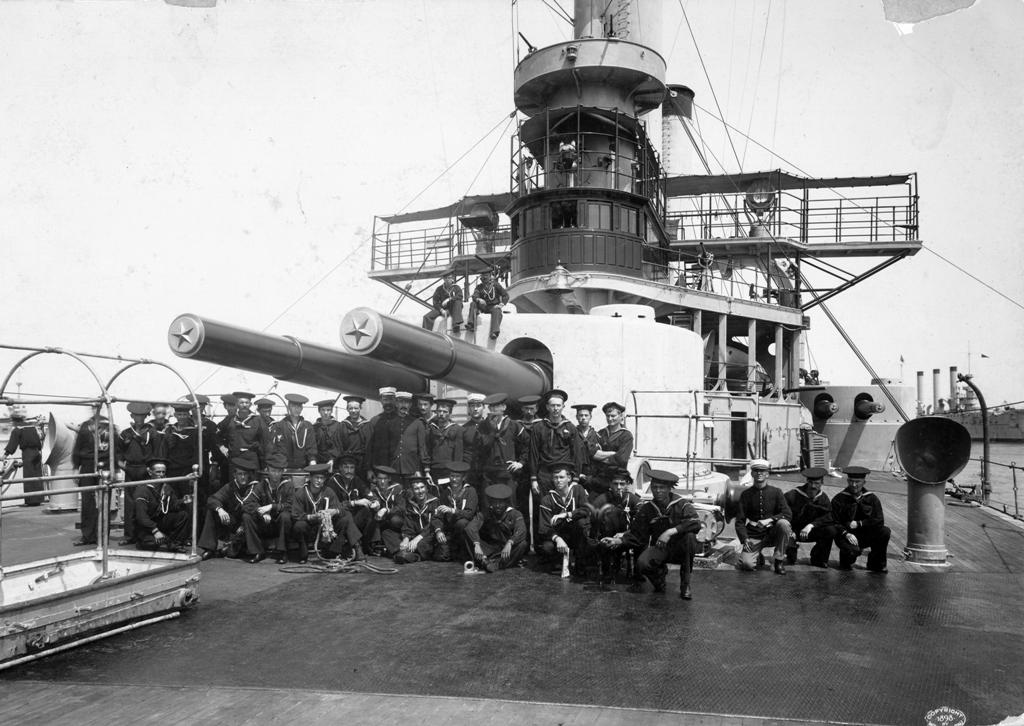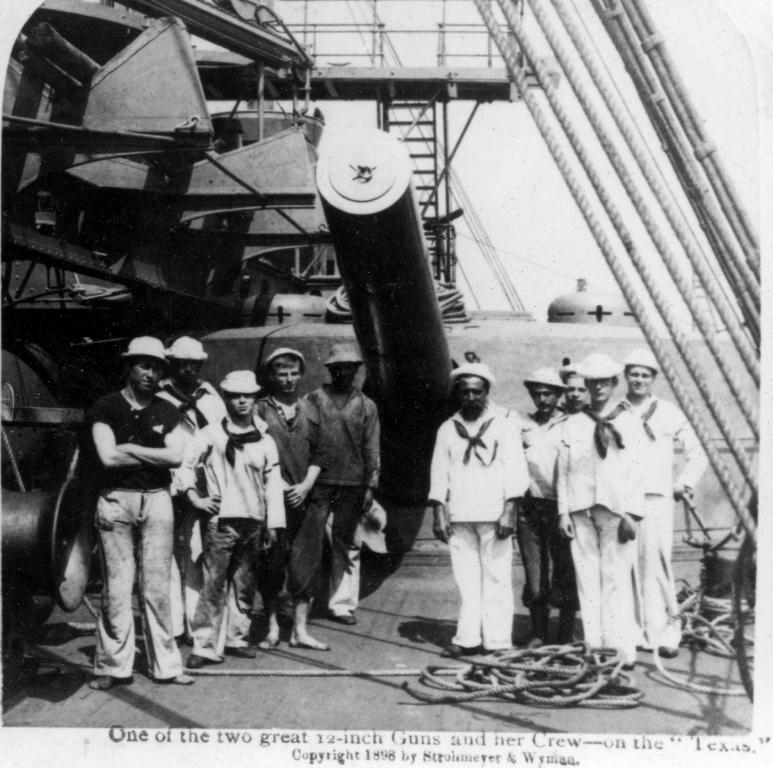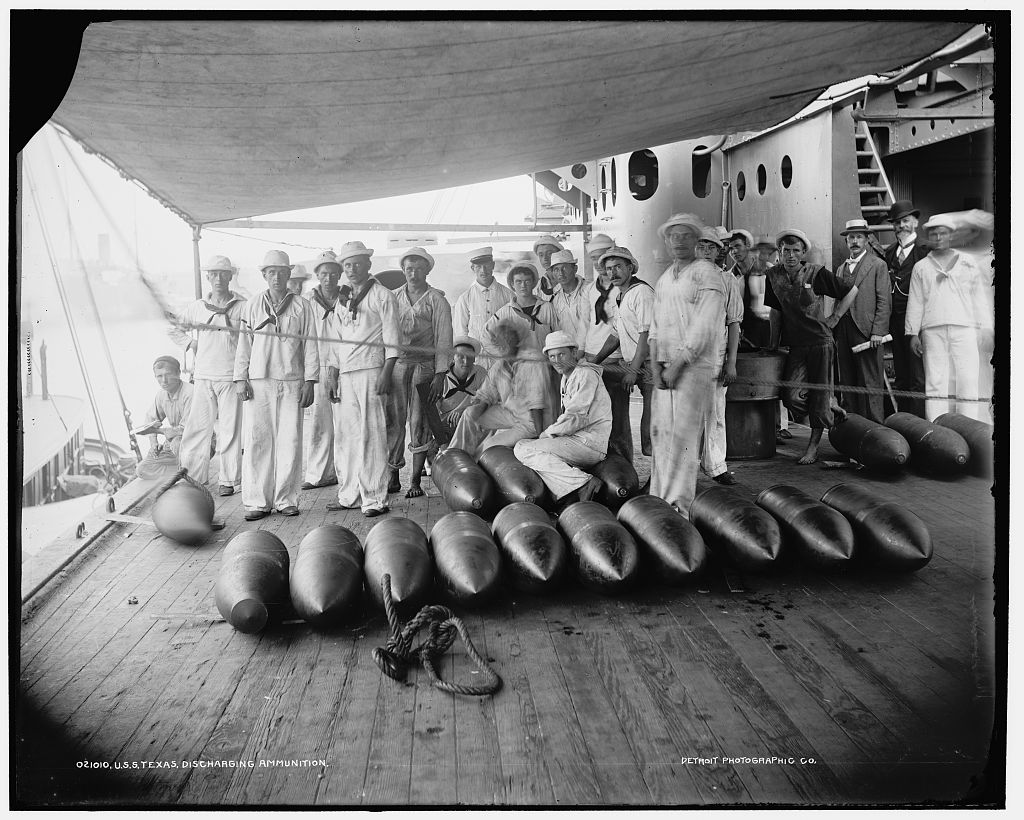
In 1890 the Policy Board called for a variety of large caliber weapons, all the way up to 16" (40.3 cm) although this last caliber was beyond the technology of the day. A lighter-weight heavy weapon was also desired for long-range battleships and coastal monitors, which led to the development of the 12"/35 (30.5 cm).
The Mark 1 was fitted to the Second-Class Battleship Texas and some monitors, the very similar Mark 2 was fitted to the USS Iowa B-4.
In 1908 AP projectiles were fitted with a more streamlined ballistic cap of 7crh which improved their long-range penetration ability.
Background note: The gunpowder propellants used for most of the 19th century burned very quickly, giving the projectiles a short, sharp kick. For guns using these propellants, the longer the gun barrel, the slower the muzzle velocity due to friction after the propellant had already finished combustion. This is why the heavy guns of the black-powder era had such short barrels, some only 20 calibers long. The late 1800s saw the development of brown or cocoa powders which burned more slowly, allowing guns like the 12"/35 (30.5 cm) to have longer barrels with higher muzzle velocities. However, these propellants also wasted much of their energy in producing thick, heavy smoke. Around the turn of the century nitrocellulose propellants (known in the USN as "Smokeless Powder" or SP) were introduced and these led to much longer weapons and higher muzzle velocities. See the Naval Technical Board essay "Naval Propellants - A Brief Overview" for additional information. These nitrocellulose propellants did create overpressure problems when used in the older, black powder guns and Gun No. 9 on USS Iowa (B-4) burst in April 1903.
The Mark 1 consisted of A tube, jacket, ten hoops and a locking ring, all constructed of gun steel. The original Mod 0 was hooped from muzzle to six inches (15.24 cm) before the breech. Mod 1 was hooped all the way to the breech. The Mark 2 construction was A tube, seven hoops and a locking ring. Hooped similarly to Mark 1 Mod 1 and designed to have the same external dimensions as that weapon. Mark 2 Mod 1 and Mod 2 were given new, nickel-steel liners and had the outer B hoops replaced with new gun-steel ones with the finished external dimensions being unchanged. This rebuilding program predated the accident on USS Iowa (B-4) but she had not yet been rearmed with the stronger guns. My research suggests that these guns used the Farcot side-swing breech mechanism and later the Fletcher breech mechanism. With the Fletcher mechanism, the breech could be opened and closed again by two men in 25 seconds.
| Designation | 12"/35 (33 cm) Mark 1 and Mark 2 |
|---|---|
| Ship Class Used On | Mark 1: Texas (1896), Puritan (M-1)and Monterey (M-6)
Mark 2: Iowa (B-4) |
| Date Of Design | N/A |
| Date In Service | 1896 |
| Gun Weight | 102,550 lbs. (46,516 kg) (including breech)
100,800 lbs. (45,722 kg) (without breech) |
| Gun Length oa | 441 in (11.0201 m) |
| Bore Length | 425 in (10.795 m) |
| Rifling Length | N/A |
| Grooves | N/A |
| Lands | N/A |
| Twist | Increasing RH 0 to 1 in 25 |
| Chamber Volume | N/A |
| Rate Of Fire 1 | 1890s: 0.2 to 0.4 rounds per minute
1900s: 2 rounds per minute |
- ^In 1897, these guns were rated at one round every 300 seconds (five minutes). This was greatly improved by more careful loading practices and better training so that by a decade later a rate of 30 seconds or less was achieved.
| Type | Bag |
|---|---|
| Projectile Types and Weights | AP - 870 lbs. (394.6 kg)
Common - 870 lbs. (394.6 kg) |
| Bursting Charge | AP - 18.0 lbs. (8.2 kg) Black Powder
Common - 28 lbs. (12.7 kg) Black Powder |
| Projectile Length | N/A |
| Propellant Charge | 160 lbs. (72.6 kg) |
| Muzzle Velocity | 2,100 fps (640 mps) |
| Working Pressure | 15.5 tons/in2 (2,440 kg/cm2) |
| Approximate Barrel Life | N/A |
| Ammunition stowage per gun | Texas: 80 rounds
Iowa: 60 rounds Others: N/A |
| Elevation | With AP Shells |
|---|---|
| 15 degrees
(maximum elevation of turrets) |
About 12,000 yards (10,970 m) 1a |
| 30 degrees | 21,000 yards (19,200 m) |
- ^It should be mentioned that this maximum range was of little use at the time these ships were built. Fire control systems and rangefinders capable of accurately firing at ranges over 10,000 yards (9,140 m) were nonexistent.
| Designation | Single Turrets
Texas (2): Mark 2 Twin Turrets
|
|---|---|
| Weight | Mark 1: N/A
Mark 2: N/A Mark 3: 448 tons (455 mt) |
| Elevation | Mark 1: -3 / +15 degrees
Mark 2: -5 / +15 degrees Mark 3: -3 / +14 degrees |
| Rate of Elevation | N/A |
| Train | about -150 / +150 degrees |
| Rate of Train | N/A |
| Gun Recoil | N/A |
| Loading Angle | Mark 1: +9.5 degrees
Mark 2: 0 degrees 2b Mark 3: +3 degrees 3b |
- ^The monitor Monterey was unusual in that she had a twin 12"/35 (30.5 cm) turret forward and a twin 10"/30 (25.4 cm) turret aft.
- ^The Mark 2 turrets on Texas originally could only load at 0 degrees train angle as well as at 0 degrees elevation. This because the hydraulic rammers for these guns were located outside of the turrets in the fixed structure and so did not rotate with the turrets. Shortly before the start of the Spanish-American War, internal telescoping rammers were fitted inside of the turrets which then allowed the guns to be loaded at any angle of train.
- ^The Mark 3 was the first balanced rotating turret in USN service. It could be loaded either by hand or with an electric rammer.




"Naval Weapons of World War One," "US Naval Weapons" and "US Battleships: An Illustrated Design History" all by Norman Friedman
"Battleships" by Paul Stillwell
---
"Naval Ordnance"
article in "Proceedings July 1894" Vol. 20/3/71 by P.R. Alger, Professor of Mathematics, U.S. Navy
---
"Ordnance and Gunnery, A Text-book Prepared for the Use of the Midshipmen of the United States Naval Academy" by Officers of the U.S. Navy (1910)
"Annual Report of the Chief of the Bureau of Ordnance to the Secretary of the Navy" for 1903, available here
---
Tony DiGiulian's personal files
19 September 2008 - Benchmark
08 May 2015 - Redid photographs of Iowa and Texas
19 July 2016 - Converted to HTML 5 format
30 October 2020 - Added ammunition data, burst gun on Iowa (B-4) and reorganized notes
09 October 2021 - Added photograph of Battleship Iowa turret
14 May 2023 - Added note about ROF
21 June 2023 - Added comments regarding Farcot and Fletcher breech mechanisms
